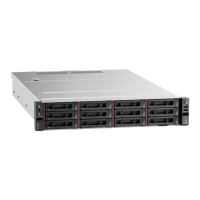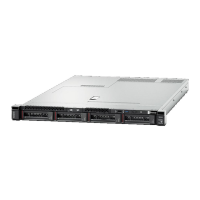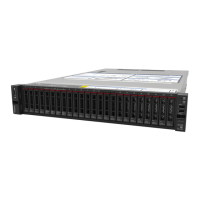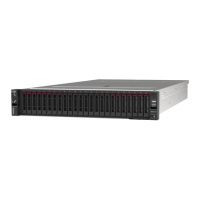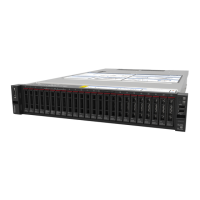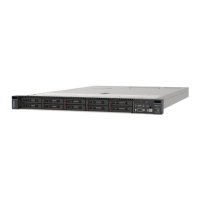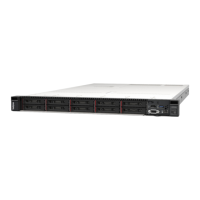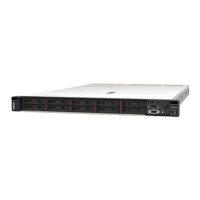Do you have a question about the Lenovo ThinkSystem SR550 and is the answer not in the manual?
Perform the following steps to first launch the UEFI setup utilities.
The setup utilities can be launched in graphic or text mode.
Display the basic details of the system.
Controls the tools that are started using the F1 key or equivalent command.
This menu displays onboard devices and I/O port options.
This menu displays the health of the controllers in the system as reported by their corresponding drivers.
This menu displays a list of foreign devices, including unclassified devices, video devices, input devices, onboard devices, and other devices.
Configures system UEFI firmware execution environment preferences for supporting legacy OS and legacy Option ROM.
This menu displays and provides options to change the memory setting.
This menu displays network devices and network related setting.
Select the operating mode based on your preference.
Use this menu to configure power scheme options.
This menu displays and provides options to change the processor settings.
Configures recovery policies and advanced reliability, availability, and serviceability settings.
Use this menu to configure system security settings.
Use this menu to manage storage adapter options.
Use this menu to set the local Date and Time of the system.
Boot a desired selection from the primary boot sequence.
Choose boot order, boot parameters, and boot from a file.
Use this menu to configure the management controller.
Clear or view the System Event Log.
Set or change Power-On and Administrator passwords.
Perform the following steps to first launch the UEFI setup utilities.
The setup utilities can be launched in graphic or text mode.
Display the basic details of the system.
Controls the tools that are started using the F1 key or equivalent command.
This menu displays onboard devices and I/O port options.
This menu displays the health of the controllers in the system as reported by their corresponding drivers.
This menu displays a list of foreign devices, including unclassified devices, video devices, input devices, onboard devices, and other devices.
Configures system UEFI firmware execution environment preferences for supporting legacy OS and legacy Option ROM.
This menu displays and provides options to change the memory setting.
This menu displays network devices and network related setting.
Select the operating mode based on your preference.
Use this menu to configure power scheme options.
This menu displays and provides options to change the processor settings.
Configures recovery policies and advanced reliability, availability, and serviceability settings.
Use this menu to configure system security settings.
Use this menu to manage storage adapter options.
Use this menu to set the local Date and Time of the system.
Boot a desired selection from the primary boot sequence.
Choose boot order, boot parameters, and boot from a file.
Use this menu to configure the management controller.
Clear or view the System Event Log.
Set or change Power-On and Administrator passwords.
| Tcase | 81 °C |
|---|---|
| Stepping | M0 |
| Scalability | 4S |
| Processor code | SR3GF |
| Processor cache | 16.5 MB |
| Processor cores | 12 |
| Processor model | 5118 |
| System bus rate | - GT/s |
| Processor socket | LGA 3647 (Socket P) |
| Processor threads | 24 |
| Processor codename | Skylake |
| Execute Disable Bit | Yes |
| Processor frequency | 2.3 GHz |
| Processor cache type | L3 |
| Processor lithography | 14 nm |
| Processor manufacturer | Intel |
| Processor package size | 76.0 x 56.5 mm |
| Processor boost frequency | 3.2 GHz |
| Processor operating modes | 64-bit |
| Supported instruction sets | AVX, AVX 2.0, AVX-512, SSE4.2 |
| Thermal Design Power (TDP) | 105 W |
| Number of processors installed | 1 |
| Maximum number of PCI Express lanes | 48 |
| Memory types supported by processor | DDR4-SDRAM |
| Memory channels supported by processor | Hexa |
| Memory clock speeds supported by processor | 2666 MHz |
| Maximum internal memory supported by processor | 768 GB |
| Memory slots | 24x DIMM |
| Internal memory | 16 GB |
| Maximum internal memory | 3072 GB |
| Memory layout (slots x size) | 1 x 16 GB |
| Power supply | 750 W |
| Power supply input frequency | 50 - 60 Hz |
| HDD size | - \ |
| RAID levels | 0, 1, 5, 6, 10, 50, 60, JBOD |
| Optical drive type | No |
| Supported HDD sizes | 2.5 \ |
| Total storage capacity | 0 GB |
| Maximum storage capacity | 61.4 TB |
| Number of HDDs installed | - |
| Supported RAID controllers | 930-8i |
| Supported storage drive interfaces | SAS, Serial ATA III |
| Cabling technology | 10/100/1000Base-T(X) |
| USB 2.0 ports quantity | USB 2.0 ports have a data transmission speed of 480 Mbps, and are backwards compatible with USB 1.1 ports. You can connect all kinds of peripheral devices to them. |
| PCI Express slots version | 3.0 |
| PCI Express x8 (Gen 3.x) slots | 2 |
| Chassis type | Rack (2U) |
| Performance management | XClarity Standard |
| Trusted Platform Module (TPM) version | 1.2 |
| Operating altitude | 0 - 3048 m |
| Storage temperature (T-T) | -10 - 60 °C |
| Operating temperature (T-T) | 5 - 45 °C |
| Operating relative humidity (H-H) | 8 - 90 % |
| Sustainability certificates | ENERGY STAR |
| Processor ARK ID | 120473 |
| Intel TSX-NI version | 1.00 |
| Depth | 763.7 mm |
|---|---|
| Width | 482 mm |
| Height | 86.5 mm |
